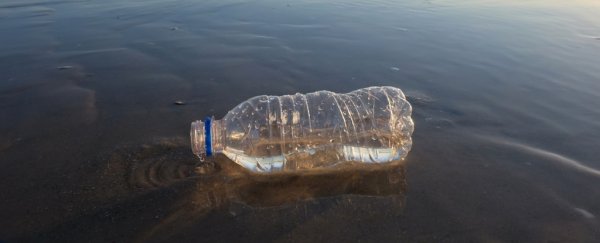Some soil microbes adept at recycling plants have developed a taste for plastic. A few years ago, while fiddling with one of these highly adapted organisms, scientists accidentally created a mutant enzyme, capable of devouring 20 percent more plastic than its natural counterpart.
Just two years later, the same team has once again outdone themselves. Combining a newly discovered enzyme with the old version, they've created a new super mutant enzyme that efficiently breaks down PET.
The huge surge in efficiency could represent a possible avenue for future plastic recycling, although at the moment, avoiding plastic products is still the most effective way to manage our pollution.
Today, human-made plastic waste has virtually invaded every crevice of our planet, and PET (aka polyethylene terephthalate) is the most common thermoplastic of them all, generally used in water bottles and clothing.
In the natural world it takes centuries for this plastic to break down fully, but even in the short time these products have existed on our planet, some microbes have figured out how to munch through them in mere days.
In 2016, the first of these organisms was discovered at a recycling plant in Japan - Ideonella sakaiensis. Over the years, research has shown it secretes a plastic-degrading enzyme called PETase to break down PET water bottles.
Now, we've discovered a second one, and labelled it MHETase. Together, the two enzymes create the perfect plastic-destroying partnership.
While PETase breaks down the surface of plastics, researchers say the new enzyme chops things up even further, until all that's left are the basic building blocks, offering the promise of essentially recycling the plastic in full.
"[I]t seemed natural to see if we could use them together, mimicking what happens in nature," explains structural biologist John McGeehan, who has been part of the research at the University of Portsmouth from the beginning.
Simply mixing PETase with the new enzyme MHETase was enough to double the breakdown of PET. But when scientists physically linked them "like two Pac-men joined by a piece of string", they worked even better.
Using the powerful Diamond Light Source synchrotron in the UK as a source of intense X-ray beams, McGeehan and his colleagues revealed the structure of the new enzyme through X-ray crystallography, which then allowed them to painstakingly attach the two, creating an inseparable duo.
"It took a great deal of work on both sides of the Atlantic, but it was worth the effort," says McGeehan.
"[W]e were delighted to see that our new chimeric enzyme is up to three times faster than the naturally evolved separate enzymes, opening new avenues for further improvements."
In nature, it's not unusual for microbe-secreted enzymes to work alongside one another, breaking down cellulose, chitin, and other tough cell structures.
"Given that natural microbial systems evolved over millions of years to optimally degrade recalcitrant polymers, perhaps it is thus not surprising, in hindsight, that a soil bacterium such as I. sakaiensis evolved the ability to utilise [..] a two-enzyme system," the authors write.
When trying to engineer faster and more efficient ways to break down plastic waste, researchers think a cocktail of plastic-demolishing enzymes is likely to be better than simply one individual - and this super mutant destroyer could certainly be a piece in that puzzle.
"Going forward, the design of multienzyme systems for depolymerisation of mixed polymer wastes is a promising and fruitful area for continued investigation," the team concludes in their paper.
The study was published in the Proceedings of the National Academy of Sciences.
